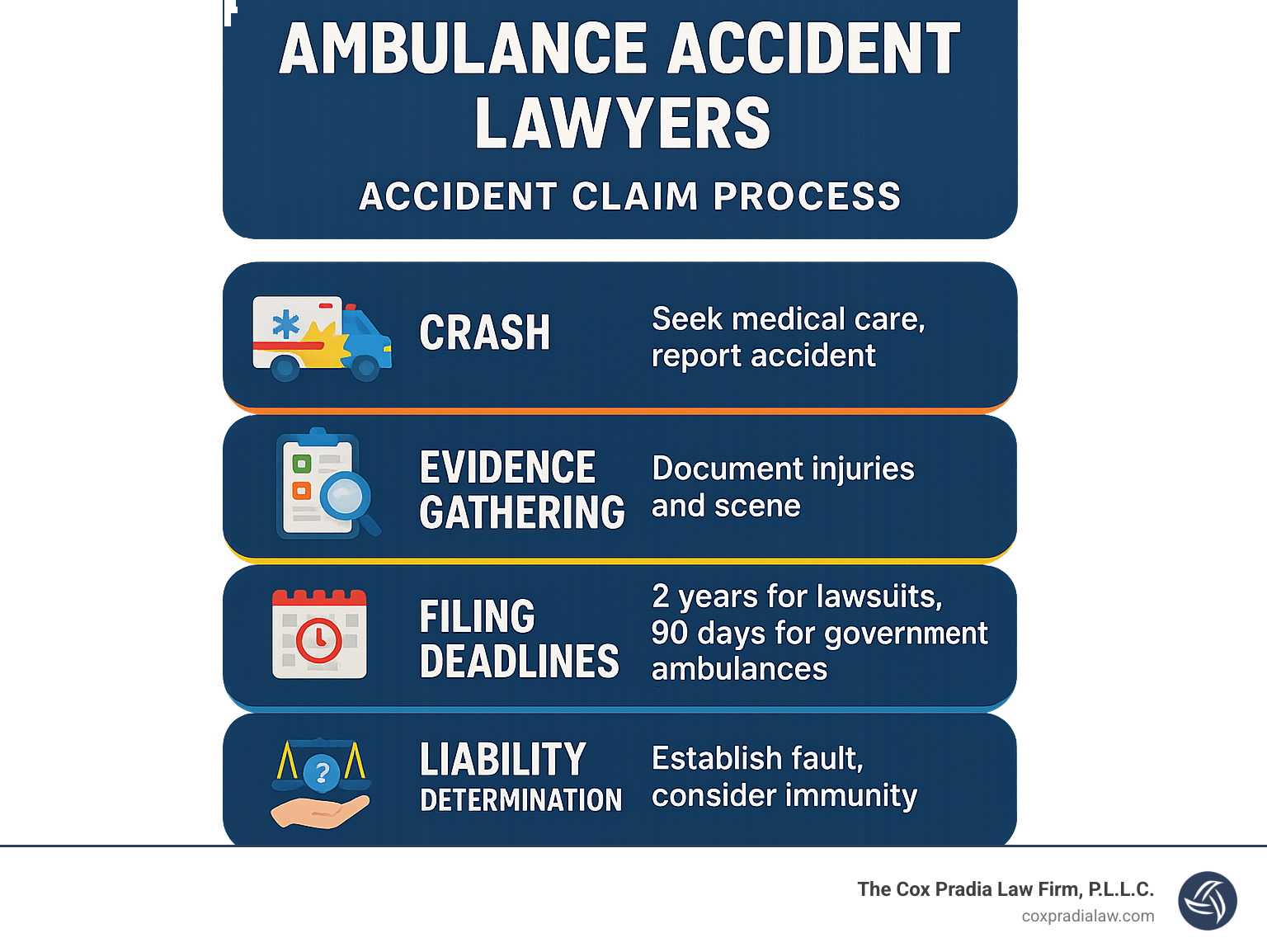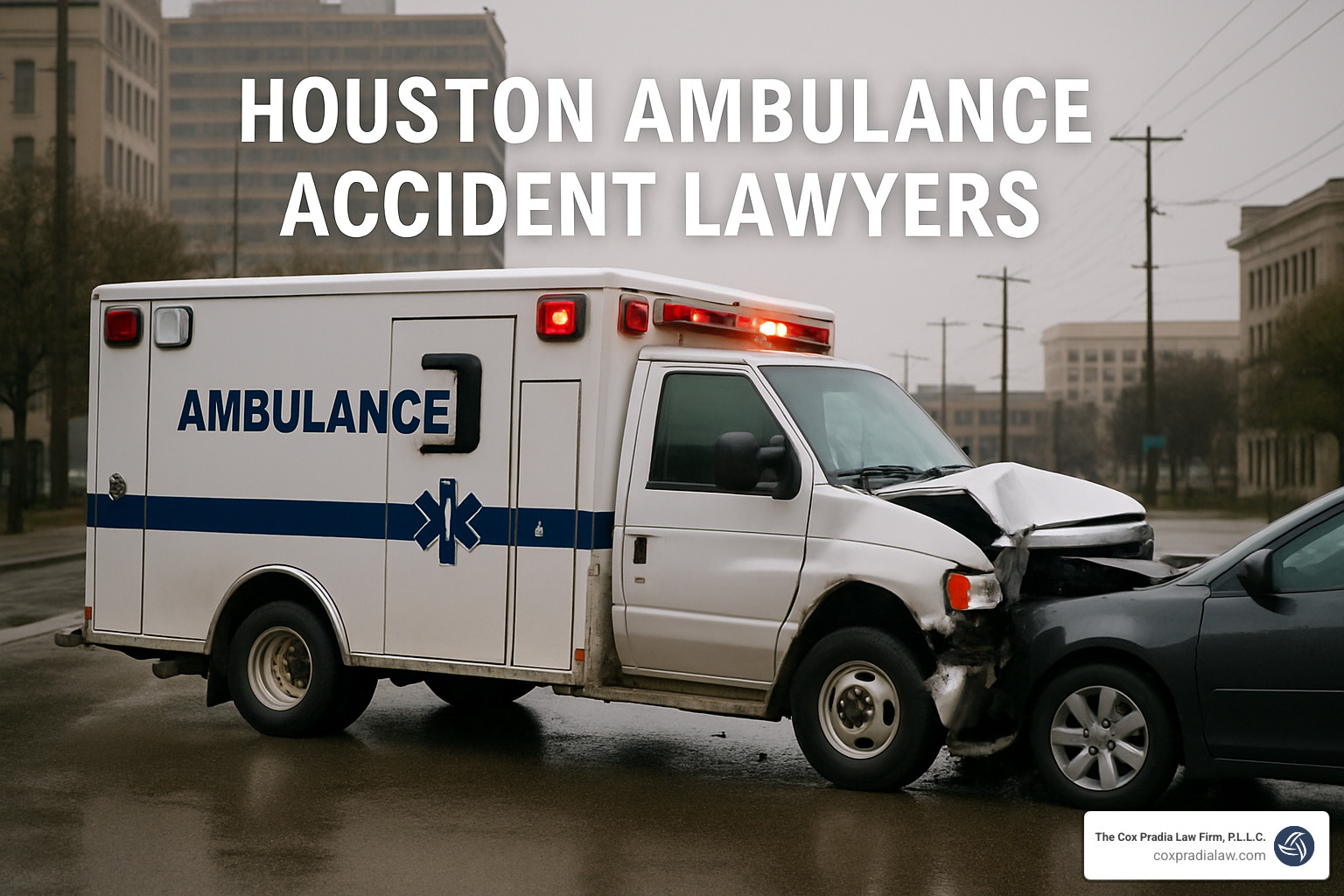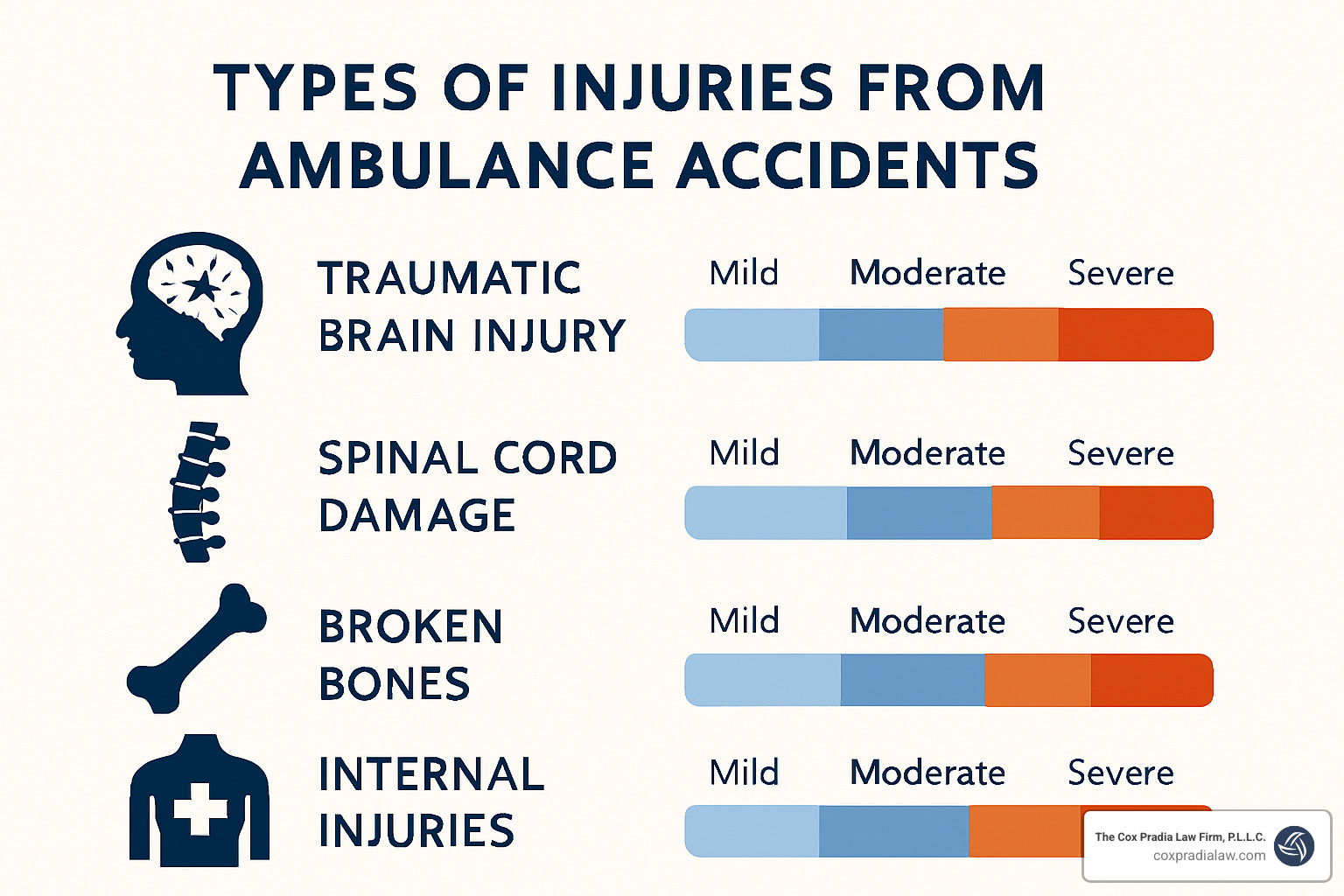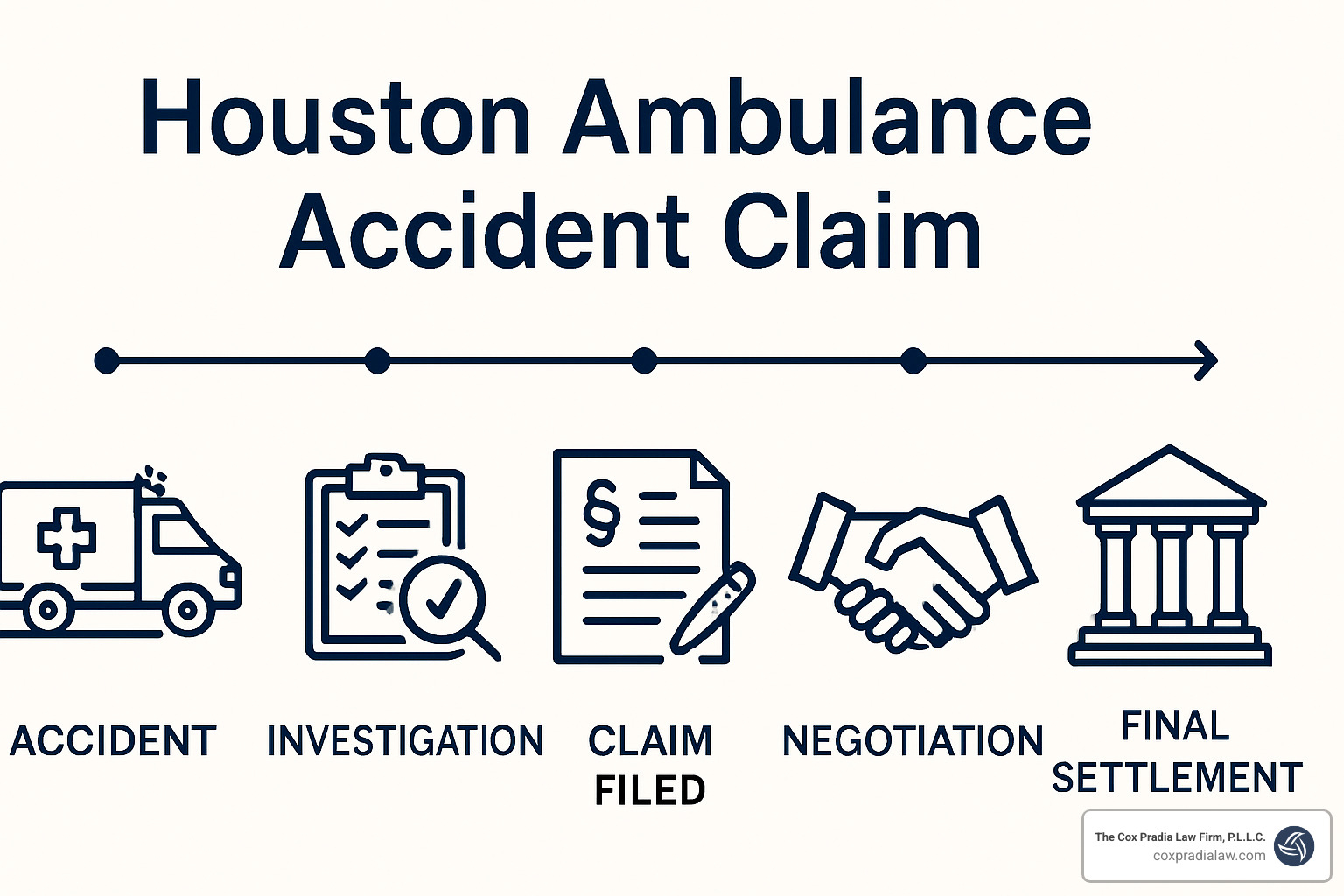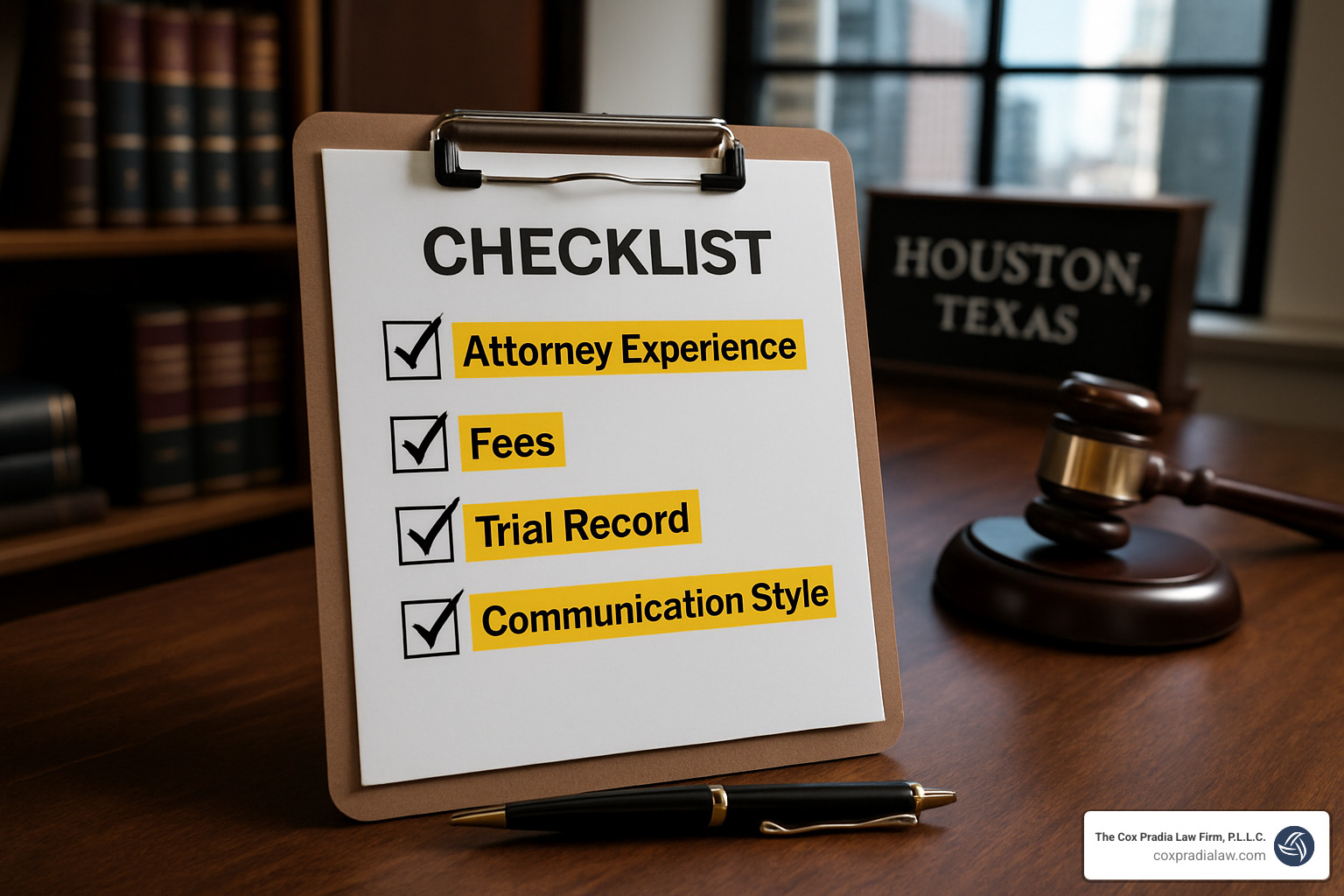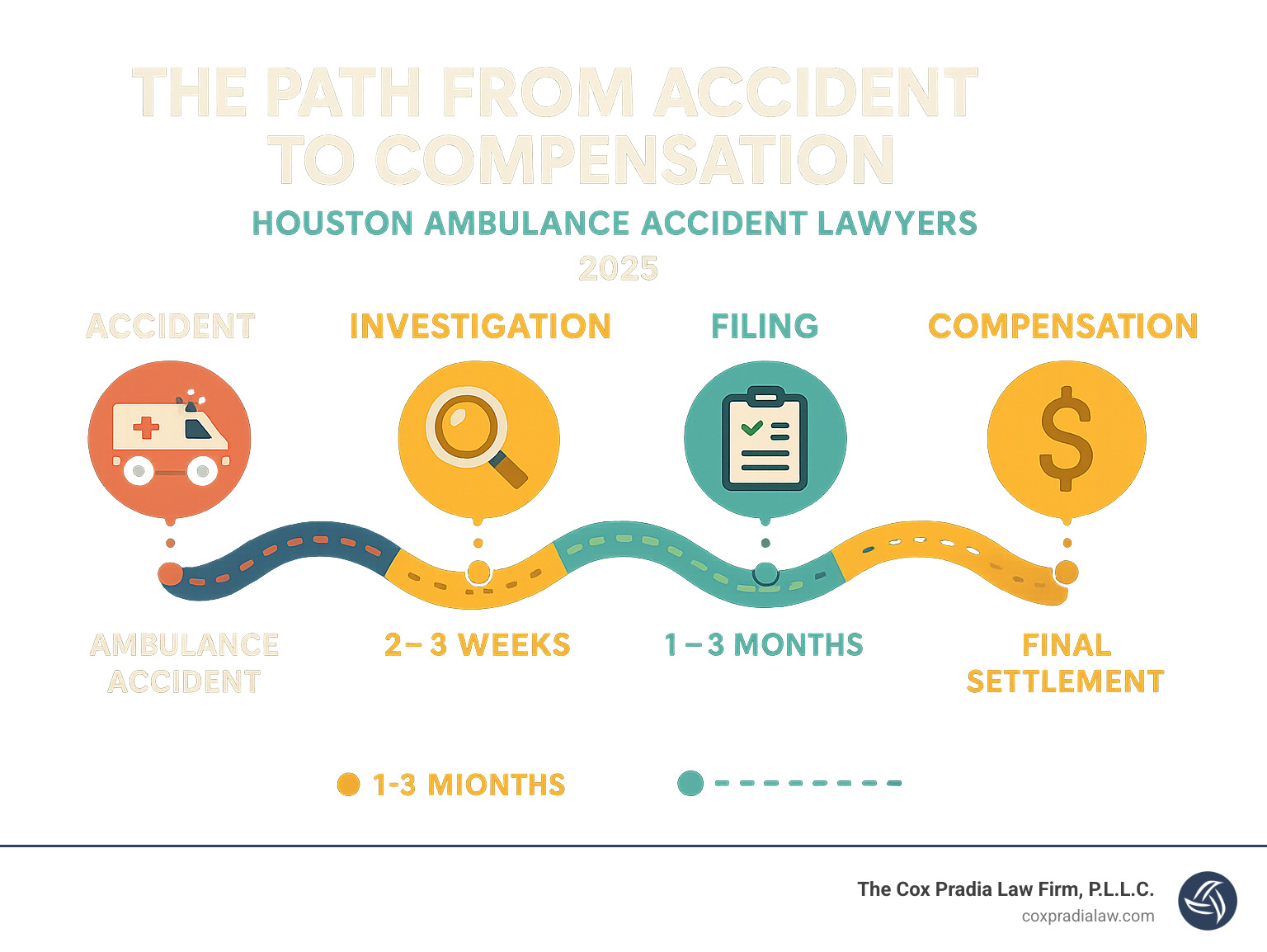When Emergency Responders Become the Emergency
Houston ambulance accident lawyers help victims steer the complex legal challenges that arise when life-saving vehicles cause devastating injuries instead of preventing them. If you’ve been injured in an ambulance collision, here’s what you need to know immediately:
Top Houston Ambulance Accident Lawyers – Quick Guide:
- Immediate Action: Seek medical care, document the scene, contact police
- Legal Deadlines: 2 years for lawsuits, 90 days notice for government ambulances
- Common Causes: Driver fatigue, excessive speed, failure to yield, equipment malfunction
- Your Rights: Compensation for medical bills, lost wages, pain and suffering
- Special Challenges: Official immunity, modified traffic laws, multiple defendants
Ambulances are trusted to transport patients safely, but approximately 6,500 accidents involving ambulances occur annually in the U.S., with an average of 2,600 people injured each year. Nearly 60% of these crashes happen during emergency response, when high speeds and flashing lights create dangerous conditions.
The legal landscape becomes even more complicated because ambulance drivers operate under different traffic rules than regular motorists. Emergency vehicles can legally exceed speed limits and run red lights under Texas Transportation Code §546.001, but they must still exercise reasonable care. When they don’t, victims face unique challenges including official immunity defenses and shortened filing deadlines.
What makes ambulance accidents different from regular car crashes?
- Modified traffic laws give ambulances special privileges
- Government-operated ambulances have sovereign immunity protections
- Multiple parties may be liable (driver, ambulance company, municipality)
- Stricter notice requirements and shorter deadlines apply
- Expert testimony often needed to prove negligence
I’m Jonathan H. Cox, and I’ve spent over 20 years helping Houston residents recover from serious injuries, including complex cases involving emergency vehicles where houston ambulance accident lawyers must overcome official immunity and steer government liability rules. My experience as a former prosecutor gives me unique insight into how these cases unfold in court.
Essential houston ambulance accident lawyers terms:
Immediate Actions to Protect Your Health & Claim
The moments after an ambulance accident are crucial for both your health and your legal claim. Your actions in these first critical hours can determine whether you receive full compensation for your injuries or face an uphill battle against well-funded insurance companies.
First, ensure everyone’s safety. If possible, move to a safe location away from traffic. Call 911 immediately – even though an ambulance is already on scene, you need police to create an official crash report. This report becomes vital evidence in your case.
Seek medical evaluation immediately, even if you feel fine. Many serious injuries like traumatic brain injury and spinal damage don’t show symptoms for hours or days. Having immediate medical documentation creates a clear link between the accident and your injuries – something insurance companies will challenge if you delay treatment.
Document everything at the scene. Take photos and videos of:
- All vehicles involved, including damage patterns
- The ambulance’s lights and sirens status
- Skid marks and debris
- Street signs and traffic signals
- Weather and road conditions
- Your visible injuries
Gather witness information. Bystanders provide crucial testimony about whether the ambulance was using proper emergency signals, driving recklessly, or violating traffic laws. Get their names, phone numbers, and brief statements about what they saw.
Preserve electronic evidence. Modern ambulances have GPS tracking, dash cameras, and “black box” data recording speed, braking, and other critical information. This evidence can disappear quickly, so immediate legal action is essential to preserve it.
Avoid these common mistakes:
- Don’t admit fault or apologize
- Don’t sign anything except police reports
- Don’t give recorded statements to insurance companies
- Don’t post about the accident on social media
- Don’t delay seeking medical attention
For detailed guidance on building your case, read our comprehensive guide on the role of evidence in building a case.
Evidence That Wins for houston ambulance accident lawyers
Houston ambulance accident lawyers know that winning these complex cases requires specific types of evidence that regular car accident attorneys might overlook. The key is proving that the ambulance driver’s actions went beyond reasonable emergency response and crossed into negligence.
Injury documentation must be immediate and thorough. Emergency room records, X-rays, CT scans, and physician notes create the medical foundation of your case. Take photos of visible injuries like bruises, cuts, and swelling – these often heal quickly but provide powerful visual evidence.
Vehicle damage analysis tells the story of impact forces and collision dynamics. Professional accident reconstruction experts can determine vehicle speeds, impact angles, and whether the ambulance driver had time to avoid the crash.
Siren and light status is crucial because ambulances only have special traffic privileges when properly using emergency signals. Witness testimony, dispatch records, and ambulance equipment logs help establish whether the crew followed proper protocols.
Driver logs and employment records reveal whether the EMT was properly trained, certified, and following work hour regulations. Fatigue from long shifts contributes to many ambulance accidents – EMS driver fatality rates are twice the national average for all workers.
GPS and dispatch records show the ambulance’s exact route, speed, and response status. This data proves whether the driver was truly responding to an emergency or returning to base without special traffic privileges.
Why You Need Houston Ambulance Accident Lawyers After a Crash
Ambulance accident cases involve legal complexities that general personal injury attorneys often can’t handle effectively. The stakes are too high to trust your case to someone without specific experience in emergency vehicle litigation.
Modified traffic laws create the first major hurdle. Under Texas Transportation Code § 546.001, ambulances can exceed speed limits and proceed through red lights when responding to emergencies, but only after “slowing down as necessary for safe operation.” Proving they violated this standard requires expert testimony and detailed accident reconstruction.
Official immunity protects government employees from lawsuits unless they acted with “reckless disregard” for public safety. This higher standard means you can’t just prove the ambulance driver was careless – you must show they acted with conscious indifference to known risks.
Municipal notice deadlines are much shorter than regular personal injury claims. While you have two years to sue private parties, claims against government entities often require written notice within 90 days. Missing this deadline can destroy your case entirely.
Multiple defendants complicate liability and increase potential recovery. You might sue the ambulance driver, the EMS company, the municipality, equipment manufacturers, and other motorists. Each defendant has different insurance coverage and legal protections.
Comparative fault rules in Texas follow a 51% standard – if you’re more than 50% responsible for the accident, you recover nothing. Insurance companies aggressively argue that civilian drivers should have yielded to the ambulance, even when the EMT was driving recklessly.
Vicarious liability extends responsibility to employers when their employees cause accidents during work duties. However, government entities have special protections that require experienced legal navigation.
Research shows that most EMTs don’t fully understand emergency driving laws. A scientific study of 293 EMTs found that most knew only one of five emergency vehicle operation rules, highlighting the training gaps that contribute to preventable accidents.
| Ambulance Accident Claims | Regular Auto Accident Claims |
|---|---|
| Modified traffic laws apply | Standard traffic laws apply |
| Official immunity defenses | No immunity protections |
| 90-day government notice | 2-year statute of limitations |
| Multiple government defendants | Typically private parties only |
| Higher negligence standards | Standard negligence proof |
| Specialized expert testimony | General accident reconstruction |
How houston ambulance accident lawyers Overcome Official Immunity
Houston ambulance accident lawyers use specific strategies to pierce the official immunity shield that protects government ambulance drivers. Success requires proving the driver acted with “reckless disregard” rather than simple negligence.
Negligence proof focuses on policy violations and training failures. We examine whether the driver followed Emergency Vehicle Operator Course (EVOC) protocols, used proper signals, and observed intersection safety rules. Documented violations help establish reckless conduct.
Reckless disregard standard requires showing the driver knew their actions created substantial risk but proceeded anyway. Examples include excessive speeding in heavy traffic, running red lights without slowing, or driving while fatigued despite known safety risks.
Expert reconstruction uses physics and engineering to demonstrate how the accident occurred and whether reasonable alternatives existed. These experts often testify that proper emergency driving techniques would have prevented the collision.
Policy violations provide the strongest evidence of reckless conduct. When ambulance drivers violate written protocols for emergency response, it demonstrates conscious disregard for public safety rather than split-second judgment errors.
Liability, Injuries & Compensation Breakdown
Understanding who can be held responsible and what compensation you deserve is crucial for maximizing your recovery after an ambulance accident. These cases often involve multiple liable parties and severe injuries that require comprehensive medical treatment.
Common causes of ambulance accidents include:
Driver fatigue affects nearly all EMS workers due to long shifts and high-stress environments. Sleep-deprived drivers have reaction times similar to drunk drivers, making them dangerous on Houston’s busy streets.
Distracted driving occurs when EMTs use radios, GPS systems, or medical equipment while driving. Unlike regular drivers, ambulance crews often multitask during emergency responses, increasing crash risk.
Other motorists cause accidents by failing to yield to emergency vehicles or making sudden lane changes when they hear sirens. However, ambulance drivers must still exercise reasonable care to avoid these predictable hazards.
Equipment failure includes brake problems, steering malfunctions, and siren/light failures that prevent proper emergency signaling. Poor maintenance by ambulance companies creates liability for resulting accidents.
Road defects like potholes, inadequate signage, or poor lighting contribute to crashes, especially when ambulances travel at high speeds. Municipalities can be liable for dangerous road conditions.
Typical injuries in ambulance accidents:
Traumatic brain injury occurs frequently due to high-impact collisions. These injuries often require lifelong medical care and can cost millions in treatment and lost earning capacity.
Spinal damage ranges from herniated discs to complete paralysis. Ambulance accidents involving large, heavy vehicles create tremendous forces that can crush vertebrae and damage the spinal cord.
Wrongful death cases arise when victims die from their injuries. Families can recover funeral expenses, lost income, and compensation for the deceased’s pain and suffering before death.
Compensation categories include:
Medical bills cover emergency treatment, surgery, rehabilitation, and future medical needs. We work with life care planners to calculate lifetime treatment costs for severe injuries.
Lost wages include both past and future income losses. High-earning professionals who can’t return to work may recover millions in lost earning capacity.
Pain and suffering compensates for physical pain, emotional trauma, and reduced quality of life. These damages often exceed economic losses in severe injury cases.
Punitive damages may apply when ambulance drivers act with malice or gross negligence. Texas caps these damages but they can significantly increase total recovery.
National Safety Council data shows that the average cost of a “disabling” injury crash exceeds $1.2 million, while “possible” injury crashes average $160,000. Ambulance accidents often fall into the severe category due to vehicle size and speed.
Shared fault reductions apply when victims bear partial responsibility. For example, if you’re 20% at fault for failing to yield, your recovery decreases by 20%. Our attorneys fight these allegations aggressively.
For additional safety tips, read our guide on car crash injury lawyer tips to prevent accidents.
Calculating Pain & Suffering in houston ambulance accident lawyers Cases
Houston ambulance accident lawyers use sophisticated methods to calculate pain and suffering damages that reflect the true impact of your injuries. These non-economic damages often represent the largest portion of your settlement.
Multiplier method takes your economic damages (medical bills and lost wages) and multiplies by a factor of 1.5 to 5 based on injury severity. Catastrophic injuries like paralysis or brain damage warrant higher multipliers.
Per-diem method assigns a daily value to your pain and multiplies by the number of days you’ll experience symptoms. This approach works well for injuries with clear recovery timelines.
Catastrophic multipliers apply when injuries cause permanent disability or disfigurement. These cases often use multipliers of 5 to 10 or higher, reflecting the lifelong impact on your quality of life.
Future care projections consider ongoing medical needs, adaptive equipment, and home modifications. Life care planners create detailed cost estimates that extend decades into the future.
Filing Insurance Claims & Lawsuits in Texas
The claims process for ambulance accidents involves strict deadlines and complex procedures that can trap unwary victims. Understanding these requirements is essential for protecting your rights and maximizing recovery.
Two-year statute of limitations applies to most personal injury claims in Texas. However, this deadline can be shorter for government entities, and findy of injuries may extend the filing period in some cases.
90-day city notice requirements apply when suing municipalities that operate ambulances. This notice must describe the accident, injuries, and damages in detail. Failure to comply can bar your entire claim.
Insurance carrier notice should happen immediately after the accident. However, don’t give recorded statements or sign documents without legal representation. Insurance adjusters often use these statements against you later.
Claim forms vary depending on whether you’re dealing with private insurance or government entities. Government claims require specific forms and procedures that differ from standard insurance processes.
Settlement talks typically begin after medical treatment is complete and damages are fully understood. Experienced attorneys know when to negotiate and when to proceed to trial for maximum recovery.
Litigation phases include findy, depositions, expert testimony, and trial preparation. Most cases settle before trial, but having a trial-ready attorney increases settlement value.
Mediation and trial provide alternatives when settlement negotiations fail. Mediation offers a less formal resolution process, while trial gives you the opportunity to present your case to a jury.
Contingency fee basics mean you pay nothing upfront and attorney fees come from your recovery. This arrangement aligns our interests with yours – we only get paid when you win.
For detailed information about filing deadlines, read our comprehensive guide on Texas statute of limitations for personal injury.
Government-entity problems create additional complexity because sovereign immunity limits damages and requires special procedures. These cases often involve damage caps that don’t apply to private defendants.
Special Deadlines When the Ambulance Is Government-Operated
Houston notice requirements are particularly strict for city-operated ambulances. You must provide written notice within 90 days that includes specific information about the accident, your injuries, and the damages you’re claiming.
Harris County forms have different requirements for county-operated EMS services. These forms must be filed at specific locations and include detailed accident descriptions and witness information.
Sovereign immunity caps limit damages against government entities to $250,000 per person and $500,000 per incident in many cases. However, these caps don’t apply when the government purchases insurance or waives immunity.
Choosing the Right Lawyer & Building a Winning Team
Selecting the right attorney for your ambulance accident case is crucial because these claims involve specialized knowledge that general personal injury lawyers often lack. The wrong choice can cost you hundreds of thousands of dollars in compensation.
Experience with emergency vehicle cases is non-negotiable. Look for attorneys who have successfully handled ambulance, fire truck, and police vehicle accidents. These cases require understanding of emergency vehicle regulations, official immunity, and government liability rules.
Trial record matters because insurance companies pay more to attorneys they know will take cases to court. Ask about recent verdicts and settlements in similar cases, not just general personal injury results.
Resources for experts separate top firms from the rest. Ambulance accident cases require accident reconstruction specialists, medical experts, life care planners, and economists. Quality experts are expensive but essential for maximum recovery.
Compassionate communication helps you steer the emotional trauma of serious injuries. Look for attorneys who return calls promptly, explain complex legal concepts clearly, and treat you like family rather than just another case number.
Free consultation should be standard for personal injury cases. During this meeting, evaluate whether the attorney understands your case, has relevant experience, and makes you feel comfortable about moving forward.
Client reviews provide insight into how attorneys treat clients and handle cases. Look for patterns in reviews about communication, results, and overall satisfaction.
For comprehensive guidance on this important decision, read our complete guide to choosing a personal injury lawyer in Houston.
Red flags to avoid:
- Attorneys who guarantee specific results
- Firms that pressure you to sign immediately
- Lawyers who don’t specialize in personal injury
- Attorneys who won’t discuss their experience with similar cases
- Firms that charge upfront fees for injury cases
Questions to Ask Prospective houston ambulance accident lawyers
Case volume: How many ambulance accident cases have you handled? What were the outcomes? This reveals whether the attorney has specific experience with these complex cases.
Recent verdicts: What are your most recent trial results in emergency vehicle cases? Attorneys should be able to discuss specific cases and outcomes without violating confidentiality.
Investigative partners: Which experts do you work with for accident reconstruction and medical testimony? Quality experts often determine case outcomes.
Fee structure transparency: What percentage do you charge, and what expenses will I be responsible for? Get clear, written fee agreements before signing anything.
Frequently Asked Questions About Houston Ambulance Accidents
What if I’m partly at fault but the ambulance hit me?
Texas follows a “51% rule” for comparative fault – you can still recover compensation as long as you’re not more than 50% responsible for the accident. Your recovery will be reduced by your percentage of fault, but you won’t be completely barred from compensation.
For example, if you failed to yield to an ambulance but the EMT was driving recklessly without proper signals, you might be found 30% at fault. In this case, you’d recover 70% of your total damages. Houston ambulance accident lawyers fight these fault allegations aggressively because even small percentage changes can mean thousands of dollars in your pocket.
How long will my ambulance accident case take in Houston?
Most ambulance accident cases take 12-24 months to resolve, though complex cases involving severe injuries or government entities can take longer. The timeline depends on several factors:
- Medical treatment completion: We typically don’t settle until you’ve reached maximum medical improvement
- Government involvement: Cases against city or county ambulances take longer due to special procedures
- Injury severity: Catastrophic injuries require extensive documentation and expert testimony
- Defendant cooperation: Some insurance companies negotiate in good faith while others force litigation
Simple cases with clear liability and minor injuries might settle in 6-12 months, while wrongful death or paralysis cases often take 2-3 years to fully resolve.
Can passengers inside the ambulance sue for additional injuries?
Yes, ambulance passengers can sue for injuries caused by the crash, even if they were already injured or ill. These cases often involve:
- Additional injuries from the collision that worsened the original condition
- Failure to secure patients properly on gurneys or stretchers
- Delayed medical treatment due to the accident
- Emotional trauma from the crash experience
Passengers face unique challenges because they must prove the accident caused new injuries separate from their pre-existing conditions. Medical experts play a crucial role in distinguishing between original injuries and crash-related harm.
Conclusion
Ambulance accidents create devastating injuries and complex legal challenges that require immediate, experienced representation. The unique aspects of these cases – from official immunity to shortened deadlines – mean that your choice of attorney can determine whether you receive full compensation or walk away with nothing.
Your next steps should be:
- Seek immediate medical attention for any injuries, even if they seem minor
- Document everything about the accident scene and your injuries
- Contact experienced houston ambulance accident lawyers before talking to insurance companies
- Preserve evidence by acting quickly to protect electronic data and witness testimony
Emotional recovery takes time, and you shouldn’t have to worry about legal complexities while you heal. The right attorney handles all aspects of your case so you can focus on getting better.
Financial security depends on maximizing your compensation through skilled negotiation and, if necessary, aggressive trial advocacy. Insurance companies count on victims accepting quick, low-ball settlements. Don’t let them take advantage of your situation.
At The Cox Pradia Law Firm, we understand the unique challenges of ambulance accident cases and have the experience to overcome official immunity, steer government liability rules, and secure maximum compensation for our clients. We offer free, compassionate case reviews where we’ll evaluate your claim and explain your options without any obligation.
The path from accident to compensation involves many steps, but you don’t have to walk it alone. Our team guides you through every phase of the process, from initial evidence gathering through final settlement or trial verdict.
For more information about maximizing your claim, read our guide on how Houston injury lawyers help maximize your claim. You can also learn more about your rights after a car wreck to understand the full scope of your legal options.
Ambulance accidents are not just “bad luck” – they’re often preventable crashes caused by driver negligence, poor training, or equipment failures. You have the right to hold responsible parties accountable and secure the compensation you need to rebuild your life.
Don’t let the complexity of these cases intimidate you. With the right legal team by your side, you can steer the challenges and achieve the justice you deserve. Contact us today to begin your journey toward recovery and compensation.

